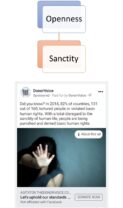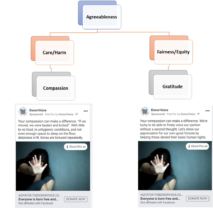Is the Donor Missing From Your Messaging?
We’ve got a simple recipe or heuristic for messaging. It’s,
- Four parts donor (unique to the donor)
- 1 part your brand (unique to you)
- 1 part Issue X (not unique, lots of competition)
While simple to write and deliver, even in the limited “real-estate” of a Facebook ad, the rigor lies in knowing the unique to donor messaging parts.
Our four parts are based in the psychology of giving. If your messaging doesn’t explicitly hit on all four parts then it is missing the mark by failing to fully connect with the person on the receiving end and asking that person to do extra, cognitive work to see themselves in the message. And since humans are mostly cognitive misers, most aren’t willing to do the extra work as 2nd gift conversion and first-year retention metrics bear out.
The four parts are,
-
- Identity. This goes well beyond generic labels of “donor”, “supporter” or internal definitions (active, lapsed, sustainer/regular giver, advocate). An innate identity is what’s required, one that has nothing to directly do with your brand or their interaction with it.
- Personality. There are 5 uber Personality traits. We all have all five but to very different degrees. The dominant one or two dictate your disposition, your general demeanor, your attitudes and choices in what you’ll pay attention to or ignore.
- Moral Frame. If your charity is involved with helping, conserving, preserving, fighting, advocating, etc. then you are in the morality business and people are making moral judgments about supporting you. However, this isn’t a binary moral/not moral decision. If I am more religious or conservative or Conscientious (Big 5 Personality trait) then I am more likely to be using a Sancity moral lens. If my personality is more Agreeable (another Big 5) and I’m liberal and a female than I’m more likely to use a Care/Harm moral lens. Both supporters could elect to support your cause but for very different reasons. The only way to increase the chance of either or both supporting is to message to them differently.
- Emotion. Make it emotional… Is that useful guidance? We didn’t think so either. Emotion is paradoxically talked about the most and the least understood. As it turns out, certain emotions link directly and innately to certain Moral frames. Understand this and you understand what emotion to use. Absent this, it’s all guesswork.
Getting beyond theory to applied is our bread and butter, our Raison d’être. This visual represents an (intentionally) incomplete taxonomy cracking the code of the ‘four parts donor” ingredient in the recipe (minus Identity).
This taxonomy gets your messaging and creative where it needs to be,
-
- Strategic
- Tied to evidence and data
- Gets you out of the one size fits all approach to a world where we truly become donor centric with segments defined entirely by their innate characteristics and that provides an almost paint by numbers approach to messaging to save time and endless hours of fruitless debate that often leaves the best ideas not discussed or on the cutting room floor.
A couple important take-aways,
-
- This taxonomy includes targeting that uses proxy data (2nd party in digital, 3rd party for mail) to find people in digital realms and score lists (acquisition and house file) for mail or TM. No more having to rely on getting each person to answer survey questions. We can have our cake and eat it too – individualized treatment at scale.
- The linkages aren’t random. Certain Personalities link to certain Moral Lens that link to certain emotions. For example, an ad aimed at an Agreeable, Care/Harm oriented person that doesn’t use Compassion as the emotion will always be sub-optimum to one that does use Compassion.

Here are examples of ads that fit a specific human profile within this taxonomy. They are very different ads aimed at different people with very different messaging. But, it isn’t random and isn’t relying on someone with “strategy” or “creative” in their title to divine these ads.
Nor is it relying on random, black box clustering often done by a person with no more understanding of the clustering than the client on the receiving end. The latter is however, the one stuck deciding whether to print out the persona, PP slides for wallpaper or quietly hit the delete button lest anyone else find out the chasm between the slides and useful, applicable intel is Grand Canyon wide.


We’ll be publishing more of our taxonomy over time but some of this will necessarily be proprietary. That said, we’ll offer courses to train smaller charities and take applications to join the next piloting on this work for larger brands. Same holds for agencies, we’ll train smaller ones and partner with larger, vetted ones.
Stay tuned for more details or drop a note directly to inquire.
Kevin



I would like to learn more about courses offered and pricing.
Hi Paula,
we’re launching a Supporter Motivation Course in January. You can find more information about the course, including price, here: http://agitator.thedonorvoice.com/donorvoice-course-the-science-of-supporter-motivation/